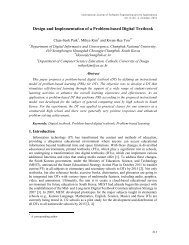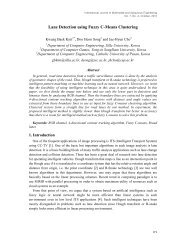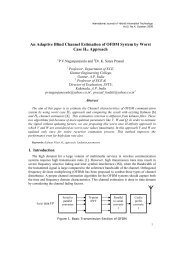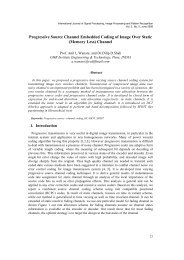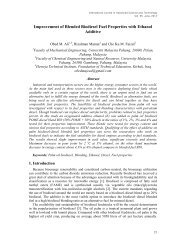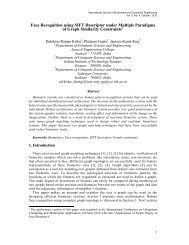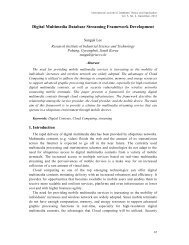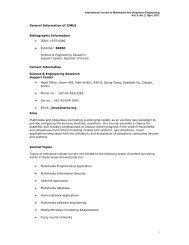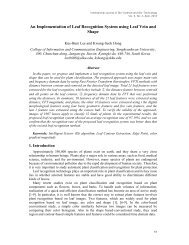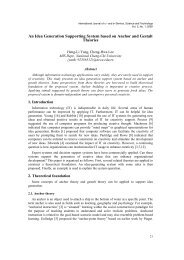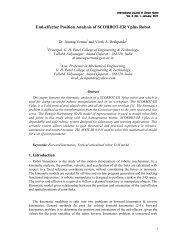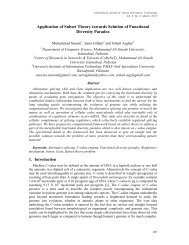A Communication Protocol of RFID Systems in Internet of Things
A Communication Protocol of RFID Systems in Internet of Things
A Communication Protocol of RFID Systems in Internet of Things
Create successful ePaper yourself
Turn your PDF publications into a flip-book with our unique Google optimized e-Paper software.
International Journal <strong>of</strong> Security and Its Applications<br />
Vol. 6, No. 2, April, 2012<br />
A <strong>Communication</strong> <strong>Protocol</strong> <strong>of</strong> <strong>RFID</strong> <strong>Systems</strong> <strong>in</strong> <strong>Internet</strong> <strong>of</strong> Th<strong>in</strong>gs<br />
HuiDan Gao,YaJun Guo*,JianQun Cui, HengGeng Hao and Hui Shi<br />
Department <strong>of</strong> Computer Science, Central Ch<strong>in</strong>a Normal University<br />
Wuhan 430079, Ch<strong>in</strong>a<br />
ccnugyj@126.com,gaodan8703@126.com<br />
Abstract<br />
Radio frequency identification (<strong>RFID</strong>) is one <strong>of</strong> the key technologies which constitute<br />
<strong>in</strong>ternet <strong>of</strong> th<strong>in</strong>gs. Security and privacy issues <strong>of</strong> <strong>RFID</strong> systems is the focus <strong>of</strong> the present<br />
study. By analyz<strong>in</strong>g several typical <strong>RFID</strong> security protocols, for the special security<br />
requirements <strong>of</strong> <strong>RFID</strong> systems <strong>in</strong> <strong>in</strong>ternet <strong>of</strong> th<strong>in</strong>gs, <strong>in</strong> the paper, we propose a<br />
communication protocol SPAP(security-provable authentication protocol), then analyze and<br />
demonstrate the security <strong>of</strong> the protocol <strong>in</strong> details by the random oracle model. Analysis show<br />
that the protocol not only can solve the tag track<strong>in</strong>g, replay attack, clon<strong>in</strong>g attack and the tag<br />
<strong>in</strong>formation <strong>in</strong>dist<strong>in</strong>guishable, but also can solve the <strong>in</strong>ternal attack and the ownership<br />
transfer <strong>of</strong> tags and other issues <strong>of</strong> <strong>RFID</strong> <strong>Systems</strong> <strong>in</strong> <strong>in</strong>ternet <strong>of</strong> th<strong>in</strong>gs. F<strong>in</strong>ally, accord<strong>in</strong>g to<br />
the comparisons, SPAP has the best performance.<br />
Keywords: <strong>Internet</strong> <strong>of</strong> Th<strong>in</strong>gs; <strong>RFID</strong>; EPC; SPAP; Random oracle model.<br />
1. Introduction<br />
<strong>Internet</strong> <strong>of</strong> Th<strong>in</strong>gs is one <strong>of</strong> the hottest topics <strong>in</strong> the IT <strong>in</strong>dustry, is the mature stage <strong>of</strong> the<br />
development <strong>of</strong> <strong>Internet</strong>. This means it can appear at any time, any place, any object can be<br />
l<strong>in</strong>ked with this ubiquitous network. Although the concept <strong>of</strong> <strong>in</strong>ternet <strong>of</strong> th<strong>in</strong>gs has been<br />
widely recognized, scholars from worldwide have been study<strong>in</strong>g and promot<strong>in</strong>g its<br />
application all the time, the development <strong>of</strong> <strong>in</strong>ternet <strong>of</strong> th<strong>in</strong>gs still faces many difficulties,<br />
especially the privacy issues <strong>in</strong> the <strong>RFID</strong> systems.<br />
<strong>RFID</strong> systems <strong>in</strong> <strong>in</strong>ternet <strong>of</strong> th<strong>in</strong>gs[1,2] consist <strong>of</strong> readers, EPC tags, <strong>RFID</strong> middleware<br />
components. The wireless data communication technology between EPC tags and readers can<br />
make the systems vulnerable to retransmit, track, tamper, counterfeit. In addition, security<br />
issues <strong>of</strong> the ownership transfer <strong>of</strong> tags are also very important, design<strong>in</strong>g safe and efficient<br />
<strong>RFID</strong> security systems is necessary for <strong>in</strong>ternet <strong>of</strong> th<strong>in</strong>gs. The methods to achieve the security<br />
<strong>of</strong> <strong>RFID</strong> systems conclude physical methods, password mechanisms and comb<strong>in</strong>ation <strong>of</strong><br />
them. As physical methods are defective, security mechanisms bas<strong>in</strong>g on the password<br />
technology are the focus <strong>of</strong> today's researches. Currently, there are varieties <strong>of</strong> <strong>RFID</strong> security<br />
protocols that have been proposed, but the protocols have their own shortcom<strong>in</strong>gs. To date,<br />
there is not a specific security protocol to meet all the security requirements <strong>of</strong> <strong>RFID</strong> systems<br />
<strong>of</strong> <strong>in</strong>ternet <strong>of</strong> th<strong>in</strong>gs. What’s more, us<strong>in</strong>g the theory <strong>of</strong> provable security to prove the security<br />
authentication protocol is an important research direction, however, the example <strong>of</strong> us<strong>in</strong>g the<br />
provable security theory to analyze security authentication <strong>RFID</strong> protocol is very poor. For<br />
solv<strong>in</strong>g the above problems, this paper presents a security authentication that can be<br />
successfully used <strong>in</strong> <strong>RFID</strong> systems <strong>of</strong> <strong>in</strong>ternet <strong>of</strong> th<strong>in</strong>gs, and proves its safety by the random<br />
oracle model [3].<br />
This paper is constructed as follows: Section 2 analyses and compares the exist<strong>in</strong>g typical<br />
<strong>RFID</strong> security protocols. Section 3 describes the model <strong>of</strong> <strong>RFID</strong> systems <strong>of</strong> <strong>in</strong>ternet <strong>of</strong> th<strong>in</strong>gs,<br />
91
International Journal <strong>of</strong> Security and Its Applications<br />
Vol. 6, No. 2, April, 2012<br />
and def<strong>in</strong>es its security needs. Section 4 proposes a Provable Secure Authentication SPAP,<br />
and proves its security. Section 5 analyses the performance <strong>of</strong> SPAP. Section 6 makes a<br />
conclusion.<br />
2. The Exist<strong>in</strong>g Typical <strong>RFID</strong> Security <strong>Protocol</strong><br />
Today, <strong>RFID</strong> technology has been widely used <strong>in</strong> many areas because <strong>of</strong> its strong<br />
anti-<strong>in</strong>terference, easy operation, etc. At the same time, security and privacy issues <strong>of</strong><br />
<strong>RFID</strong> system are <strong>in</strong>creas<strong>in</strong>gly exposed. Scholars from various countries <strong>in</strong> the world try<br />
their best to make a series <strong>of</strong> solutions, such as the Hash-Lock protocol bas<strong>in</strong>g on hash<br />
functions and random numbers [4], the randomized Hash-Lock protocol[5];the library<br />
<strong>RFID</strong> protocol bas<strong>in</strong>g on shared pseudo and random function keys[6]; the Ownership<br />
Transfer <strong>Protocol</strong> bas<strong>in</strong>g on symmetric key algorithms[7]; and EC-RAC protocol bas<strong>in</strong>g<br />
on public key cryptography algorithms[8].<br />
The Hash-Lock protocol uses hash functions to implement the authentication between<br />
readers and tags, us<strong>in</strong>g metal ID <strong>in</strong>stead <strong>of</strong> the real ID to solve the track<strong>in</strong>g attacks, but<br />
the protocol does not use the dynamic ID mechanism, thus an attacker can still replay<br />
attacks, and track attacks. The randomized Hash-Lock protocol can resist the tag<br />
track<strong>in</strong>g attacks, but after the certification, the tag ID can still pass through the clear<br />
text form, an attacker can still replay attacks. The Library <strong>RFID</strong> protocol adopts the<br />
pre-shared key, pseudo-random function to achieve authentication, to solve the<br />
retransmission, track<strong>in</strong>g, tamper<strong>in</strong>g and other security issues, so far, no obvious defects<br />
<strong>of</strong> the protocol are found, but the cost <strong>of</strong> labels is too high. Ownership Transfer<br />
protocol us<strong>in</strong>g symmetric encryption algorithms solves the tamper<strong>in</strong>g, track<strong>in</strong>g and<br />
ownership transfer <strong>of</strong> the tag, but it cannot achieve forward security. EC-RAC protocol<br />
us<strong>in</strong>g elliptic curve public key cryptography algorithms solves the label track<strong>in</strong>g<br />
attacks, protects the security <strong>of</strong> the system, however, recent experiments reveal that the<br />
protocol still cannot resist track<strong>in</strong>g attacks.<br />
The <strong>in</strong>ternet <strong>of</strong> th<strong>in</strong>gs asks for even more special security requirements for its <strong>RFID</strong><br />
system. The connection between tags and readers <strong>in</strong> <strong>in</strong>ternet <strong>of</strong> th<strong>in</strong>gs makes the<br />
protocol take <strong>in</strong>to account <strong>of</strong> <strong>in</strong>ternal attacks <strong>of</strong> the systems, as well as the ownership<br />
transfer <strong>of</strong> tags [9]. By analyz<strong>in</strong>g the above protocols, this paper establishes a model <strong>of</strong><br />
the <strong>RFID</strong> system <strong>in</strong> <strong>in</strong>ternet <strong>of</strong> th<strong>in</strong>gs, def<strong>in</strong>es their security requirements, and proposes<br />
a new security protocol.<br />
3. The Model and Security Requirements <strong>of</strong> <strong>RFID</strong> System <strong>in</strong> <strong>Internet</strong> <strong>of</strong><br />
Th<strong>in</strong>gs<br />
3.1 The <strong>RFID</strong> System Model <strong>of</strong> <strong>Internet</strong> <strong>of</strong> Th<strong>in</strong>gs<br />
<strong>RFID</strong> systems <strong>in</strong> <strong>in</strong>ternet <strong>of</strong> th<strong>in</strong>gs ma<strong>in</strong>ly consist <strong>of</strong> readers, tags and <strong>RFID</strong> middle<br />
wares. Each object <strong>in</strong> the system has an unique EPC. We assume that <strong>in</strong> one <strong>RFID</strong><br />
system there are N legitimate readers numbered from 1 to N , there are M legitimate<br />
readers numbered from 1 to M . i (1, N)<br />
, j (1, M)<br />
,the reader i is denoted as R i<br />
,the<br />
tag j is denoted as T j<br />
.In addition, because the cable channels between the reader and<br />
database are generally considered safe, therefore, when we establish the model, the<br />
reader and database can be seen as a unified <strong>in</strong>dependent entity, that is, the reader and<br />
database are collectively referred to as the middleware server.<br />
92
International Journal <strong>of</strong> Security and Its Applications<br />
Vol. 6, No. 2, April, 2012<br />
Random Oracle model [10] is applied to describe the <strong>RFID</strong> system model <strong>in</strong> <strong>in</strong>ternet<br />
<strong>of</strong> th<strong>in</strong>gs. The model can be equivalent to a tuple P ( )<br />
, and are time<br />
functions <strong>of</strong> polynomial whose safety factor is 1 k ( k<br />
N)<br />
, def<strong>in</strong>es the behavior <strong>of</strong> a<br />
legitimate reader, def<strong>in</strong>es the operation <strong>of</strong> a legitimate tag. Us<strong>in</strong>g the random Oracle to<br />
query and def<strong>in</strong>ite the behavior <strong>of</strong> an attacker, that is, the attacker which has Oracle<br />
s<br />
s<br />
<br />
R i,T<br />
( R<br />
j i<br />
<strong>in</strong>itiates a session s with T j<br />
) and Oracle <br />
Tj,R<br />
( T<br />
i j<br />
<strong>in</strong>itiates a session s<br />
with R i<br />
)is an Oracle probability mach<strong>in</strong>e. The attacker can achieve the attack target by<br />
s<br />
s<br />
send<strong>in</strong>g scheduled questions to Oracle R i,T<br />
and Oracle <br />
j<br />
Tj,R<br />
and receiv<strong>in</strong>g response<br />
i<br />
<strong>in</strong>formation from the random Oracle. Oracle question depicts the real ability <strong>of</strong> the<br />
attacker. The attacker can send the follow<strong>in</strong>g questions.<br />
Execute ( R <br />
T<br />
, P)<br />
: the question depicts an <strong>in</strong>stance P that the attacker execute the<br />
i j<br />
protocol between T j<br />
and R i<br />
which can obta<strong>in</strong> all messages exchanged between the<br />
reader and the tag when the protocol P executes.<br />
SendTag ( <br />
T<br />
, Pm ,<br />
1)<br />
: the question depicts an <strong>in</strong>stance P that the attacker A sends the<br />
j<br />
message m<br />
1<br />
to tag T j<br />
, and receives the response message <strong>of</strong> the tag T j<br />
.<br />
SendReader ( <br />
R<br />
, Pm ,<br />
2)<br />
:the question depicts <strong>in</strong>stance P that the attacker A sends the<br />
i<br />
message m2<br />
to reader R i<br />
, and receives the response message <strong>of</strong> the reader R i<br />
.<br />
CorruptTag ( ):the question depicts an active attack on the tag and the attacker's<br />
Tj<br />
captured capacity. It can make the captured tag T j<br />
actively reveal secret <strong>in</strong>formation<br />
which is <strong>in</strong> their private storage space.<br />
CorruptRead ( ):the question depicts an active attack on the reader and the attacker's<br />
Ri<br />
captured capacity. It can make the captured reader R i<br />
actively reveal secret <strong>in</strong>formation which<br />
is <strong>in</strong> their private storage space.<br />
Test ( ):the question is used to test semantic security <strong>of</strong> confidential <strong>in</strong>formation <strong>of</strong> a tag<br />
Tj<br />
T j<br />
. By throw<strong>in</strong>g co<strong>in</strong> b , if b = 1, return the secret <strong>in</strong>formation stored <strong>in</strong> the tag. if b = 0,<br />
return an random number which is equivalent <strong>in</strong> length to the secret <strong>in</strong>formation <strong>of</strong> the tag.<br />
Test ( ):the question is used to test semantic security <strong>of</strong> confidential <strong>in</strong>formation <strong>of</strong><br />
Ri<br />
a reader R i<br />
.By throw<strong>in</strong>g co<strong>in</strong> b , if b = 1, return the secret <strong>in</strong>formation stored <strong>in</strong> the<br />
tag. if b = 0, return an random number which is equivalent <strong>in</strong> length to the secret<br />
<strong>in</strong>formation <strong>of</strong> the reader.<br />
3.2 Security Requirements <strong>of</strong> Authentication <strong>in</strong> <strong>RFID</strong> System <strong>of</strong> <strong>Internet</strong> <strong>of</strong> Th<strong>in</strong>gs<br />
An <strong>RFID</strong> system is an important part <strong>of</strong> <strong>in</strong>ternet <strong>of</strong> th<strong>in</strong>gs, non-contact automatic<br />
identification technology between the reader and the tag <strong>in</strong> the system which makes the<br />
system face serious security problems. Analyz<strong>in</strong>g the security needs met by exist<strong>in</strong>g typical<br />
<strong>RFID</strong> protocols and comb<strong>in</strong><strong>in</strong>g the characteristics <strong>of</strong> <strong>RFID</strong> system <strong>of</strong> <strong>in</strong>ternet <strong>of</strong> th<strong>in</strong>gs, what<br />
needs the authentication should meet <strong>in</strong> <strong>RFID</strong> system <strong>of</strong> <strong>in</strong>ternet <strong>of</strong> th<strong>in</strong>gs are detailed <strong>in</strong> the<br />
follow<strong>in</strong>g.<br />
93
International Journal <strong>of</strong> Security and Its Applications<br />
Vol. 6, No. 2, April, 2012<br />
Def<strong>in</strong>ition1. If for any polynomial PK ( ) and sufficiently large K ,the function can<br />
satisfy ( ) <br />
, then we say that the function can be negligible.<br />
Mutual authentication: The tag should be able to achieve the certification <strong>of</strong> legitimate<br />
reader, that is, if the attacker R achieves tag T<br />
j<br />
( j[1, M])<br />
to certificate for R i<br />
by fabricat<strong>in</strong>g<br />
reader R ( a a<br />
[1, N ]) ,we denote it as Adv( R ) . Then the probability <strong>of</strong> success <strong>of</strong> R is<br />
Pr(Adv( R)) ( K)<br />
. The reader should be able to achieve the certification <strong>of</strong> legitimate tag,<br />
that is, if the attacker T achieves reader R<br />
i<br />
( i[1, N])<br />
to certificate for T j<br />
by fabricat<strong>in</strong>g<br />
legitimate tag T ( b b<br />
[1, M ]) , we denote it as Adv( T ) . Then the success probability <strong>of</strong> T is<br />
Pr(Adv( T) ( K)<br />
.<br />
Forward security: Even if an attacker obta<strong>in</strong>s the tag status <strong>of</strong> its current time t 1<br />
, the<br />
attacker cannot connect the status with the tag status obta<strong>in</strong>ed <strong>in</strong> previous one time<br />
t1 ( t1 t2)<br />
.That is, to j [1, M]<br />
, t 1<br />
t 2<br />
, the attacker Q has already known the <strong>in</strong>formation <strong>of</strong><br />
tag T j<br />
<strong>in</strong> time t 2<br />
, then calculate the <strong>in</strong>formation <strong>of</strong> the tag T j<br />
<strong>in</strong> time t 1<br />
by the random oracle<br />
query, we denote it as Adv( Q ) . Then the success probability <strong>of</strong> R is Pr(Adv( Q)) ( K)<br />
.<br />
Indist<strong>in</strong>guishable: j1, j2 [1, M]<br />
, the attacker can’t dist<strong>in</strong>guish and identify the secret<br />
<strong>in</strong>formation <strong>of</strong> T j<br />
and T<br />
1<br />
j<br />
, so as to recognize the target. That is, if the attacker D can<br />
2<br />
dist<strong>in</strong>guish and identify the secret <strong>in</strong>formation <strong>of</strong> T j<br />
and T<br />
1<br />
j<br />
through random oracle queries,<br />
2<br />
we denote it as Iden( D ) .The success probability <strong>of</strong> D is Pr(Iden( D)) ( K)<br />
.<br />
Internal security: The legitimate reader and the legitimate tag with<strong>in</strong> the system cannot<br />
communicate with each other by forgery and tamper<strong>in</strong>g. That is, i, j [1, N]<br />
, m, n [1, M]<br />
.<br />
R<br />
i(R j<br />
) successfully identify tag T<br />
m(T n<br />
) by fabricat<strong>in</strong>g R<br />
j(R i<br />
) , we denote it as Adv( NR),<br />
Then<br />
Pr(Adv( NR) ( K)<br />
. If T<br />
m(T n<br />
) through fabricat<strong>in</strong>g T<br />
n(T m<br />
) is identified successfully by<br />
R<br />
i(R j<br />
) , we denote it as Adv( NT ) , then Pr(Adv( NT)) ( K)<br />
.<br />
Security transfer <strong>of</strong> ownership: j [1, M]<br />
, when the tag T j<br />
transfer its ownership, then<br />
the tag T j<br />
become T j<br />
<strong>in</strong> the new system. The reader <strong>in</strong> orig<strong>in</strong>al ownership system <strong>of</strong> tag<br />
T j<br />
cannot <strong>in</strong>quiry the <strong>in</strong>formation <strong>of</strong> tag T j<br />
. That is, i [1, N]<br />
, j [1, M]<br />
. The event that<br />
R i<br />
successfully get the tag T j<br />
after transferr<strong>in</strong>g the ownership <strong>of</strong> T j<br />
can be denoted as<br />
Adv( Z ) , Pr(Adv( Z)) ( K)<br />
.<br />
4. SPAP<br />
4.1 <strong>Protocol</strong> Design<br />
By analyz<strong>in</strong>g the model and safe problems which need to be solved <strong>in</strong> <strong>RFID</strong> systems <strong>of</strong><br />
<strong>in</strong>ternet <strong>of</strong> th<strong>in</strong>gs, conclud<strong>in</strong>g advantages and disadvantages <strong>of</strong> today's typical <strong>RFID</strong> security<br />
protocols, the article proposes the protocol SPAP which uses symmetric encryption, one-way<br />
hash function and XOR. We assume every legitimate readers and tags that conta<strong>in</strong> a unique<br />
EPC (Electronic Product Code),Symbols used <strong>in</strong> the protocol as Table 1<br />
94
International Journal <strong>of</strong> Security and Its Applications<br />
Vol. 6, No. 2, April, 2012<br />
EPC<br />
R i<br />
The EPC <strong>of</strong> reader i<br />
EPC<br />
T j<br />
The EPC <strong>of</strong> tag j<br />
Info( )<br />
K<br />
ij<br />
'<br />
K<br />
ij<br />
''<br />
K<br />
ij<br />
Table 1. Symbols used <strong>in</strong> the <strong>Protocol</strong><br />
EPC<br />
T<br />
Information conta<strong>in</strong>ed <strong>in</strong> EPC<br />
j<br />
T j<br />
Key between reader i and tag j<br />
Key update once<br />
Key update twice<br />
<strong>of</strong> tag j<br />
EK ij<br />
( x )<br />
Encryption function with key K ij<br />
DK ij<br />
( x )<br />
Correspond<strong>in</strong>g decryption function with EK ij<br />
( x )<br />
E ' ( x )<br />
Symmetric encryption function with key<br />
K ij<br />
E ' ' ( x )<br />
Symmetric encryption function with key<br />
K ij<br />
H( x )<br />
<br />
Rand( x )<br />
r<br />
e<br />
'<br />
e<br />
<br />
<br />
'<br />
K<br />
ij<br />
''<br />
K<br />
ij<br />
One-way hash function<br />
XOR<br />
Random number generator<br />
Random numbers<br />
Certification function used <strong>in</strong> the key update phase<br />
Certification function used <strong>in</strong> the key update phase<br />
Is equal to<br />
Update to<br />
Generally, we assume that the reader i communicates with the tag j <strong>in</strong> the <strong>RFID</strong><br />
system, The flow chart <strong>of</strong> the protocol shown <strong>in</strong> Fig1. It ma<strong>in</strong>ly consists <strong>of</strong> certification<br />
stage, key update phase and transfer stage <strong>of</strong> ownership.<br />
Tag j<br />
Saved Data<br />
E ( EPC )<br />
Kij<br />
Ri<br />
Tj<br />
H ( EPC )<br />
1. rt ,<br />
Read i<br />
3. ar ,<br />
2.2.a<br />
' '<br />
Saved Data 5.Info( EPCT<br />
), K , ,<br />
j ij<br />
e e<br />
'<br />
6. ee , H( EPC ), r<br />
Ri<br />
Database<br />
Saved Data<br />
E ( EPC ), K<br />
Kij<br />
Tj<br />
ij<br />
1. t H ( EPC ) r<br />
'<br />
Kij<br />
Ri<br />
2.1.computed t receivedt<br />
a H ( E ( EPC ) r)<br />
Kij<br />
Tj<br />
7. E ( EPC ) e E ( EPC )<br />
Tj Kij Tj<br />
'<br />
'<br />
computed e receivede<br />
E ( EPC ) E ( EPC )<br />
K<br />
K T<br />
'<br />
ij j K T<br />
ij<br />
j<br />
ij<br />
K<br />
'<br />
ij<br />
Figure 1. SPAP Flow Chart<br />
4.1.computed a receiveda<br />
4.2. D ( E ( EPC )) EPC<br />
Kij Kij Tj Tj<br />
'<br />
5. Kij<br />
H ( Kij<br />
r)<br />
e E ( EPC ) E ( EPC )<br />
K T<br />
'<br />
ij j K T<br />
ij<br />
j<br />
'<br />
e H E ' EPC<br />
K T<br />
ij<br />
j<br />
( ( ))<br />
E ( EPC ) E ( EPC )<br />
K<br />
K T<br />
'<br />
ij j K T<br />
ij<br />
j<br />
ij<br />
K<br />
'<br />
ij<br />
95
……<br />
……<br />
International Journal <strong>of</strong> Security and Its Applications<br />
Vol. 6, No. 2, April, 2012<br />
Certification Stage<br />
(1)Initialization: save H( EPCR i<br />
) <strong>in</strong> the reader i , save H( EPCR 1<br />
) H( EPC<br />
R 2<br />
) ......<br />
H( EPCR<br />
) and E<br />
N<br />
K<br />
( EPC<br />
1 T<br />
), E (<br />
2 T<br />
)...... (<br />
T<br />
)<br />
j j K<br />
EPC E<br />
j j K<br />
EPC <strong>in</strong> tag j as shown <strong>in</strong> Fig 2. And make<br />
Nj j<br />
sure H( EPCR<br />
) and E ( ),<br />
1<br />
K<br />
EPC<br />
1 j T<br />
H( EPC )<br />
j<br />
R<br />
and E ( )<br />
2<br />
K<br />
EPC<br />
2 j T<br />
...... H( EPC )<br />
j<br />
R N<br />
and EK Nj<br />
( EPCT<br />
j<br />
) put<br />
<strong>in</strong>to a one-to-one relationship. The key K1j , K2j......<br />
KNj<br />
with correspond<strong>in</strong>g<br />
E ( ),<br />
K<br />
EPC<br />
1 j T<br />
E ( )<br />
j K<br />
EPC<br />
2 j T<br />
...... E (<br />
j<br />
K Nj<br />
EPCT<br />
j<br />
) between all the readers and tag j saved <strong>in</strong> the<br />
<strong>RFID</strong> middleware database just as shown <strong>in</strong> Fig 3, and make sure K and EK<br />
( EPC<br />
1 T<br />
),<br />
K2 j<br />
and E ( EPC ) ...... K<br />
Nj<br />
and E ( EPCT<br />
) put <strong>in</strong>to a one-to-one relationship.<br />
K2 j Tj<br />
K Nj j<br />
1 j<br />
j<br />
j<br />
H( EPC<br />
R 1<br />
) EK<br />
( EPC<br />
1 T<br />
)<br />
j<br />
j<br />
H( EPC<br />
R 2<br />
) EK<br />
( EPC<br />
2 T<br />
)<br />
j<br />
j<br />
E ( EPC )<br />
K1 j Tj<br />
E ( EPC )<br />
K2 j Tj<br />
K<br />
1 j<br />
K<br />
2 j<br />
……<br />
……<br />
H( EPC ) E ( EPC<br />
T<br />
)<br />
RN<br />
K Nj j<br />
E ( EPC )<br />
K Nj T j<br />
K<br />
Nj<br />
Figure 2. Tag j <strong>in</strong>itialized<br />
Figure 3. Database Initialized<br />
(2)Reader i generates a random number r by random number generator Rand( x),<br />
generate an authentication request through the XOR H( EPC ) r t , sent rt , to the tag.<br />
(3)When receive certification request, tag j will search the<br />
Ri<br />
R i<br />
R i<br />
then<br />
H( EPC ) to satisfy<br />
H( EPC r)<br />
equal to the received t . If not found, authentication fails and the tag stops<br />
respond<strong>in</strong>g. Otherwise, cont<strong>in</strong>ue to perform the follow<strong>in</strong>g steps to f<strong>in</strong>d<br />
E ( EPC ), which is<br />
K ij T j<br />
one-to-one with reader EPC<br />
R i<br />
. Then hashes a H( EK ij<br />
( EPCT<br />
j<br />
) r)<br />
and send a to the reader.<br />
(4)When the reader receives tag response, sent a and random number r generated first to<br />
the <strong>RFID</strong> middleware.<br />
(5) After receiv<strong>in</strong>g a , <strong>RFID</strong> middleware will search the EK ij<br />
( EPC<br />
T j<br />
) to satisfy<br />
H( E ( EPC ) r)<br />
a . If it is found, certification is completed. Then cont<strong>in</strong>ue to perform the<br />
K ij T j<br />
follow<strong>in</strong>g steps, search<br />
K ,which is one-to-one with E ( EPC ).Otherwise, respond<strong>in</strong>g stops<br />
ij<br />
K ij T j<br />
to conduct DK<br />
( E (<br />
T<br />
))<br />
ij K<br />
EPC EPC<br />
ij j T<br />
symmetric decryption to obta<strong>in</strong> EPC<br />
j<br />
T j<br />
.After that, search<br />
the Info( EPC<br />
T<br />
) with EPC<br />
j<br />
T j<br />
through the <strong>in</strong>formation service system <strong>of</strong> <strong>Internet</strong> <strong>of</strong> Th<strong>in</strong>gs, and<br />
sent it to reader. If the tag needs to update the keys and transfer the ownership, cont<strong>in</strong>ue do<br />
the follow<strong>in</strong>g steps.<br />
Key Update Phase<br />
(1) <strong>RFID</strong> middleware databases generate a new key<br />
function, then encrypt<br />
K ij T j<br />
T j<br />
K H( K r)<br />
, by us<strong>in</strong>g Hash<br />
EPC with the key to generate new E ' ( EPC T<br />
) , then XOR<br />
E ( EPC ) and E ' ( EPC T<br />
) , that is e E ( EPCT<br />
) E ( EPC<br />
' T<br />
) ,then Hash function <strong>of</strong><br />
K ij<br />
j<br />
'<br />
ij<br />
Kij j K ij<br />
j<br />
ij<br />
K ij<br />
j<br />
96
International Journal <strong>of</strong> Security and Its Applications<br />
Vol. 6, No. 2, April, 2012<br />
E ( EPC ) , that is '<br />
'<br />
e H( E ( EPC<br />
' T<br />
)) , make substitution <strong>of</strong> K<br />
ij<br />
and E ' ( EPC T<br />
) to K and ij<br />
'<br />
K ij<br />
Tj<br />
E ( EPC ) .<br />
K ij T j<br />
K ij<br />
j<br />
'<br />
'<br />
(2) Send e and e to reader, the reader will send them to the tag. When receive e and e ,<br />
the tag recovers E ' ( EPC T<br />
) through e E ( EPC ).Certify if H ( E ' T<br />
' ( EPC T<br />
)) is equal to '<br />
e If<br />
K ij<br />
j<br />
it is, the verification is completed, make substitution <strong>of</strong><br />
Otherwise, Key Update Failed.<br />
K ij<br />
j<br />
K ij<br />
K ij<br />
K ij T j<br />
j<br />
E ( EPC ) to E ' ( EPC T<br />
) .<br />
j<br />
K ij<br />
j<br />
Transfer Stage <strong>of</strong> Ownership<br />
(1)In order to achieve the ownership transfer <strong>of</strong> tag T j<br />
, the orig<strong>in</strong>al owner <strong>of</strong> tag send the<br />
tag <strong>in</strong>formation to <strong>RFID</strong> middleware <strong>of</strong> new system. In the new ownership <strong>of</strong> the system,<br />
' '<br />
'<br />
<strong>RFID</strong> middleware, the reader and the tag re-run the key update phase, K H( K r),<br />
then<br />
encrypt<br />
EPC to generate E ' ' ( EPC T<br />
) ,then XOR E ( EPC ) and E ( EPC ) ,that is<br />
' ' T<br />
' T<br />
T j<br />
e '<br />
E EPC E EPC<br />
' T<br />
' '<br />
K<br />
j<br />
T<br />
ij<br />
Kij<br />
j<br />
K ij<br />
j<br />
( ) ( ) , then Hash function <strong>of</strong> E ' ' ( EPC T<br />
) , that is ' '<br />
e H( E ( EPC<br />
' ' T<br />
)) .<br />
' '<br />
make substitution <strong>of</strong> Kij<br />
and E ' ' ( EPC T<br />
) to<br />
K ij<br />
j<br />
K ij<br />
K ij<br />
'<br />
K<br />
ij<br />
and '<br />
K ij<br />
Tj<br />
E ( EPC ) .<br />
(2) Send e '<br />
and e to reader, the reader will send them to tag. When receive e and e ' ,the<br />
tag recover E ' ' ( EPC T<br />
) through '<br />
e E ( EPC<br />
' T<br />
).Certify if H ( E ' ' ( EPC T<br />
)) ) is equal to e . If<br />
K ij<br />
j<br />
K ij<br />
j<br />
it is, the verification is completed, make substitution <strong>of</strong> E ' ( EPC T<br />
) to E ( EPC ) In the new<br />
' ' T<br />
ownership system <strong>of</strong> tag T j<br />
, reader and <strong>RFID</strong> middleware systems have tag <strong>in</strong>formation <strong>of</strong><br />
updated keys, the orig<strong>in</strong>al ownership <strong>of</strong> the system no longer has any access to visit.<br />
4.2 Security <strong>of</strong> the SPAP<br />
Theorem1. SPAP can realize mutual authentication<br />
(1)Identity authentication <strong>of</strong> the reader<br />
Proposition 1.If any attacker R <strong>of</strong> PPT types successfully calculates the probability<br />
<strong>of</strong> t H( EPCR<br />
i<br />
) r to meet Pr[ t H( EPCR<br />
) r] ( K)<br />
, it achieve identity authentication <strong>of</strong><br />
i<br />
the reader.<br />
Pro<strong>of</strong>. The event that the attacker R can calculate<br />
EPCR i<br />
and r is recorded as Adv( R ) , it has the follow<strong>in</strong>g three possibilities:<br />
K ij<br />
j<br />
K ij<br />
j<br />
j<br />
R i<br />
j<br />
K ij<br />
ij<br />
K ij<br />
t H( EPC ) r without know<strong>in</strong>g<br />
1. the t maybe known by the attacker itself by <strong>in</strong>quir<strong>in</strong>g Oracles SendReader, Execute,<br />
CorruptRead and Test ( <br />
R<br />
) . We suppose it had <strong>in</strong>quired q<br />
i<br />
send<br />
times by Oracle<br />
SendReader ( <br />
R<br />
, Pm ,<br />
2)<br />
, q<br />
i<br />
exe<br />
times by Oracle Execute ( R <br />
T<br />
, P)<br />
. And output length <strong>of</strong> H (.)<br />
i j<br />
is l 1<br />
.Accord<strong>in</strong>g to the characteristics <strong>of</strong> birth attack<strong>in</strong>g[11],the possibility the attacker have<br />
right conjectures is no more than<br />
q<br />
q<br />
send<br />
l<br />
2 1<br />
exe<br />
.<br />
j<br />
ij<br />
j<br />
K ij<br />
j<br />
97
International Journal <strong>of</strong> Security and Its Applications<br />
Vol. 6, No. 2, April, 2012<br />
2. Or r has already been <strong>in</strong>quired by Oracle Execute, CorruptRead, SendReader and<br />
'<br />
Test ( ) . We suppose it <strong>in</strong>quired q times before and now <strong>in</strong>quires q times, then the<br />
Ri<br />
'<br />
q<br />
possibility the attacker have right conjectures is no more than<br />
q .<br />
3. Or the attacker successfully calculates EPCR i<br />
that the length <strong>of</strong> EPCR i<br />
is l<br />
2<br />
, the<br />
probability for attack<strong>in</strong>g successfully is<br />
In all,<br />
1<br />
.<br />
2<br />
2 l<br />
'<br />
qsend<br />
qexe<br />
q 1<br />
Pr[ t H( EPCR<br />
) r] Pr[Adv(R)] Pr[ ] ,<br />
i<br />
l1 l2<br />
2 q 2<br />
'<br />
qsend<br />
qexe<br />
q 1<br />
( K) Pr[ ], So the proposition is proved.<br />
l1 l2<br />
2 q 2<br />
(2)Identity authentication <strong>of</strong> the tag<br />
Proposition2. If the symmetric encryption is secure, any attacker T <strong>of</strong> PPT types<br />
successfully calculates the probability <strong>of</strong> a H( E ( EPCT<br />
) r)<br />
to meet<br />
K ij T j<br />
K ij j<br />
Pr[ a H( E ( EPC ) r)] ( K)<br />
, it achieve identity authentication <strong>of</strong> the reader.<br />
Pro<strong>of</strong>.The event that the attacker can calculate<br />
K ij T j<br />
a H( E ( EPC ) r)<br />
without know<strong>in</strong>g<br />
K ij T j<br />
E ( EPC ) and r is recorded as Adv( T ) , it has the follow<strong>in</strong>g three possible:<br />
1. the a maybe known by the attacker T itself by <strong>in</strong>quir<strong>in</strong>g Oracles SendReader,<br />
Execute, CorruptRead and Test ( <br />
T<br />
) ,We suppose it had <strong>in</strong>quired q<br />
j<br />
send<br />
times by Oracle<br />
SendTag ( <br />
T<br />
, Pm ,<br />
1)<br />
, q<br />
j<br />
exe<br />
times by Oracle Execute ( R <br />
T<br />
, P)<br />
.And output length <strong>of</strong> H (.) is<br />
i j<br />
l . Accord<strong>in</strong>g to the characteristics <strong>of</strong> birth attack<strong>in</strong>g[11] ,the possibility the attacker<br />
1<br />
has the right conjectures is no more than<br />
q<br />
q<br />
send<br />
l<br />
2 1<br />
2. Or r has already been <strong>in</strong>quired by Oracle Execute, CorruptRead, SendReader and<br />
'<br />
Test ( ). We suppose it <strong>in</strong>quired q times before and now <strong>in</strong>quires q times, then the<br />
Tj<br />
possibility the attacker have right conjectures is no more than<br />
3. Or the attacker can E ( EPC<br />
T<br />
), because the symmetric encryption is secure, so the<br />
K ij j<br />
probability <strong>of</strong> successfully calculat<strong>in</strong>g<br />
So<br />
K ij T j<br />
exe<br />
.<br />
E ( EPC ) is neglected.<br />
'<br />
qsend<br />
qexe<br />
q<br />
Pr[ a H( EK<br />
( EPCT<br />
) r)] Pr[Adv(T)] Pr[ ] ,<br />
ij<br />
j<br />
l1<br />
2 q<br />
'<br />
qsend<br />
qexe<br />
q<br />
( K) Pr[ ] , proposition is pro<strong>of</strong>.<br />
l1<br />
2 q<br />
Theorem 2.If the symmetrical encryption is secure, SPAP can achieve forward<br />
security.<br />
'<br />
q<br />
q .<br />
98
International Journal <strong>of</strong> Security and Its Applications<br />
Vol. 6, No. 2, April, 2012<br />
Pro<strong>of</strong>. If the attacker Q know the <strong>in</strong>formation e E ( EPC ) E ' ( EPC ),<br />
'<br />
e H E ' EPC<br />
K ij<br />
Tj<br />
( ( )) <strong>of</strong> the tag at time t 2<br />
, and successful get<br />
K ij T j<br />
Kij Tj K ij<br />
Tj<br />
E ( EPC ) and K ij<br />
at time t 1<br />
,<br />
we note the event as Adv( Q ) . The attacker execute the <strong>in</strong>quiry <strong>of</strong> Execute, SendReader,<br />
SendTag, CorruptRead, CorruptTag, Test ( <br />
T<br />
) and Test ( R<br />
) <strong>in</strong> sequence.<br />
We suppose the attacker Q <strong>in</strong>quires q exe<br />
times by Oracle Execute ( R T<br />
, P),<br />
q<br />
i j send<br />
times by Oracle SendTag ( T , Pm ,<br />
1)<br />
and SendReader ( <br />
j<br />
R<br />
, Pm ,<br />
2)<br />
, and the output length <strong>of</strong><br />
i<br />
H (.) is l 1<br />
. Accord<strong>in</strong>g to the characteristics <strong>of</strong> birthday attack, the possibility that the<br />
attacker successfully get the key <strong>of</strong> tag at time t is 2qsend<br />
qexe<br />
1<br />
Pr[Adv( Q)]<br />
<br />
, and<br />
l1<br />
2<br />
2qsend<br />
qexe<br />
can be ignored. Similarly, probability <strong>of</strong> successfully get E<br />
l<br />
K<br />
(<br />
T<br />
)<br />
1<br />
2<br />
ij<br />
EPC<br />
j<br />
can<br />
also be ignored. And the theorem is tenable.<br />
Theorem 3.SPAP can realize the Tag <strong>in</strong>formation <strong>in</strong>dist<strong>in</strong>guishable.<br />
Pro<strong>of</strong>, j1, j2 [1, M]<br />
, If the attacker D want to dist<strong>in</strong>guish and identify the secret<br />
<strong>in</strong>formation <strong>of</strong> T j<br />
and T<br />
1<br />
j<br />
, the attacker <strong>in</strong>quiries the Oracles Execute, SendReader,<br />
2<br />
SendTag, CorruptRead, CorruptTag, Test ( ) ,because SPAP can realize mutual<br />
authentication, forward security, <strong>in</strong>ternal security, security <strong>of</strong> ownership transfer, so if<br />
the event the attacker D can successfully identify and dist<strong>in</strong>guish the secret <strong>in</strong>formation<br />
<strong>of</strong> T j<br />
and T<br />
1<br />
j<br />
is recorded I den( D ) , Pr[I den( D)] ( K)<br />
.That is to say, the attacker does not<br />
2<br />
have the legitimacy, can't identify the tag <strong>in</strong>formation, also can't dist<strong>in</strong>guish between<br />
the target. So the theorem is proved.<br />
Theorem 4.SPAP can implement <strong>in</strong>ternal security.<br />
j<br />
Pro<strong>of</strong>. i, j [1, N]<br />
, m, n [1, M]<br />
, suppose that reader R<br />
i(R j<br />
) successfully identify tag<br />
T<br />
m(T n<br />
) by fabricat<strong>in</strong>g R<br />
j(R i<br />
) , we denote it as Adv( NR ) . Because it has the only key K ij<br />
between every legal reader and tag <strong>in</strong> the system, and theorem 1 has proved tag can<br />
achieve authentication <strong>of</strong> reader, so Pr(Adv( NR) ( K)<br />
. Similarly, if T<br />
m(T n<br />
) successfully<br />
identified by R<br />
i(R j<br />
) through fabricat<strong>in</strong>g T<br />
n(T m<br />
) , we denote it as Adv( NT ) , then<br />
Pr(Adv( NT) ( K)<br />
. And the theorem is tenable.<br />
Theorem 5.SPAP can realize the security <strong>of</strong> ownership transfer<br />
Pro<strong>of</strong>. Because there is the only authentication key between any tag and reader for<br />
SPAP, after the ownership transfer, the only authentication key between any tag and<br />
reader is updated, at the same time, SPAP also can realize the two-way authentication,<br />
therefore, That is, i [1, N]<br />
, j [1, M]<br />
, After ownership transfer <strong>of</strong> the tag T j<br />
, T j<br />
may<br />
become T j<br />
,the event that the read R i<br />
successfully gets <strong>in</strong>formation <strong>of</strong> the tag T j<br />
can be<br />
denoted as Adv( Z ) , Pr[Adv( Z)] ( K)<br />
. So the theorem is proved.<br />
5. Performance Analysis<br />
Safety performance[12] for a authentication is <strong>of</strong> great importance, the security <strong>of</strong><br />
SPAP and the previous typical authentication protocols are analyzed <strong>in</strong> table 2, √ and<br />
Tj<br />
i<br />
99
International Journal <strong>of</strong> Security and Its Applications<br />
Vol. 6, No. 2, April, 2012<br />
× <strong>in</strong>dicate whether the protocol has the ability to resist the attacks or not, respecti vely.<br />
From table 2, We can see clearly that SPAP can resist all k<strong>in</strong>ds <strong>of</strong> security attacks, and<br />
will be able to realize the key update and the ownership transfer <strong>of</strong> tags.<br />
Table 2. Comparison <strong>of</strong> Safety Performance<br />
<strong>RFID</strong> <strong>Protocol</strong> Hash-Lock Random Library <strong>RFID</strong> Ownership EC-RAC SPAP<br />
Hash-Lock<br />
Transfer<br />
Mutual authentication √ √ √ √ √ √<br />
Forward security √ √ √ √ √ √<br />
Internal security × × × × × √<br />
Resist track<strong>in</strong>g attack × × √ × × √<br />
Resist replay<strong>in</strong>g attack × × √ √ √ √<br />
Indist<strong>in</strong>guishable √ √ √ √ √ √<br />
Key update × × × √ √ √<br />
Ownership transfer × × × √ × √<br />
6. Conclusion and Future Work<br />
<strong>RFID</strong> systems are critical for <strong>in</strong>ternet <strong>of</strong> th<strong>in</strong>gs, therefore, the safe problems <strong>of</strong> <strong>RFID</strong><br />
systems becomes one <strong>of</strong> the ma<strong>in</strong> tasks for develop<strong>in</strong>g the <strong>in</strong>ternet <strong>of</strong> th<strong>in</strong>gs. This paper<br />
analyzes advantages and disadvantages <strong>of</strong> several typical <strong>RFID</strong> protocols, summarizes<br />
the special security needs <strong>of</strong> <strong>RFID</strong> systems <strong>in</strong> <strong>in</strong>ternet <strong>of</strong> th<strong>in</strong>gs, proposes a secureprovably<br />
authentication SPAP.<br />
Proved by the random oracle model, SPAP can achieve mutual authentications,<br />
<strong>in</strong>ternal security, ownership transfer <strong>of</strong> tags, what’s more, SPAP can also resist<br />
retransmission, track<strong>in</strong>g <strong>of</strong> some basic attacks. F<strong>in</strong>ally, accord<strong>in</strong>g to the result <strong>of</strong><br />
analyz<strong>in</strong>g the safe performance, SPAP protocol has good performance.<br />
The <strong>in</strong>novation <strong>of</strong> SPAP lies <strong>in</strong> solv<strong>in</strong>g the <strong>in</strong>ternal attacks and security issues <strong>of</strong><br />
ownership transfer for sett<strong>in</strong>g dynamic authentication keys between any legitimate tags<br />
and legitimate readers. In addition, us<strong>in</strong>g the random oracle models is also very novel.<br />
References<br />
[1] V. Kolias, I. Giannoukos, C. Anagnostopoulos, I. Anagnostopoulos, V. Loumos and E. Kayafas, “Integrat<strong>in</strong>g<br />
<strong>RFID</strong> on event-based hemispheric imag<strong>in</strong>g for <strong>in</strong>ternet <strong>of</strong> th<strong>in</strong>gs assistive applications”, Proceed<strong>in</strong>gs <strong>of</strong> the<br />
3rd International Conference on Pervasive Technologies Related to Assistive Environments, (2010) June 23-<br />
25; Samos, Greece.<br />
[2] X. Zhao and X. Wand, “Design and Implementation <strong>of</strong> Hybrid Broadcast Authentication <strong>Protocol</strong>s <strong>in</strong><br />
Wireless Sensor Networks”, International Journal <strong>of</strong> Advanced Science and Technology. Vol. 2, (2009)<br />
January.<br />
[3] G. Mart<strong>in</strong>, “A study <strong>of</strong> the random oracle model”, California, USA: University <strong>of</strong> California at Davis, (2008).<br />
[4] S. E. Sarma, S. A. Weis and D. W. Engels, “<strong>RFID</strong> systems and security and privacy implications”,<br />
Proceed<strong>in</strong>gs <strong>of</strong> the 4th International Workshop on Cryptographic Hardware and Embedded <strong>Systems</strong>, (2002)<br />
August 13–15; CA, USA.<br />
[5] S. A. Weis, S. E. Sarma, R. L. Rivest and D. W. Engels, “Security and privacy aspects <strong>of</strong> low-cost radio<br />
frequency identification systems”, Proceed<strong>in</strong>gs <strong>of</strong> the 1st International Conference on Security <strong>in</strong> Pervasive<br />
Comput<strong>in</strong>g, (2003) March 12-14, Boppard, Germany.<br />
[6] D. Molnar and D. Wagner, “Privacy and security <strong>in</strong> library <strong>RFID</strong>: Issues, practices, and architectures”,<br />
Proceed<strong>in</strong>gs <strong>of</strong> the 11th ACM Conference on Computer and <strong>Communication</strong>s Security, (2004) October 25 –<br />
29;Wash<strong>in</strong>gton, DC,USA.<br />
100
International Journal <strong>of</strong> Security and Its Applications<br />
Vol. 6, No. 2, April, 2012<br />
[7] K. Osaka, T. Takagi, K. Yamazaki and O. Takahashi, “An efficient and secure <strong>RFID</strong> security method with<br />
ownership transfer”, Proceed<strong>in</strong>gs <strong>of</strong> International Conference on Computational Intelligence and Security,<br />
(2006) November 3-6; Guangzhou, Ch<strong>in</strong>a.<br />
[8] Y. K. Lee, L. Bat<strong>in</strong>a and I. Verbauwhede, “EC-RAC (ECDLP Based Randomized Access Control): Provably<br />
Secure <strong>RFID</strong> authentication protocol”, Proceed<strong>in</strong>gs <strong>of</strong> IEEE International Conference on <strong>RFID</strong>, (2008) April<br />
16-17; Las Vegas, Nevada, USA.<br />
[9] R. J. Robles, T. Kim, “A Review on Security <strong>in</strong> Smart Home Development”, International Journal <strong>of</strong><br />
Advanced Science and Technology, Vol. 15, (2010) February.<br />
[10] B. Alomair, A. Clark, J. Cuellar and R. Poovendran, “Scalable <strong>RFID</strong> systems: a privacy-preserv<strong>in</strong>g protocol<br />
with constant-time identification”, Proceed<strong>in</strong>gs <strong>of</strong> the International Conference on Dependable <strong>Systems</strong> and<br />
Networks, (2010) June 28-July 1, Chicago, USA.<br />
[11] M. Bellare and T. Kohno, “Hash function balance and its impact on birthday attacks” Proceed<strong>in</strong>gs <strong>of</strong> the<br />
International Conference on the Theory and Applications <strong>of</strong> Cryptographic Techniques, (2004) May 2-<br />
6;Interlaken, Switzerland.<br />
[12] K. Sharma, M. K. Ghose, D. Kumar, R. P. K. S<strong>in</strong>gh and V. K. Pandey, “A Comparative Study <strong>of</strong> Various<br />
Security Approaches Used <strong>in</strong> Wireless Sensor Networks”, International Journal <strong>of</strong> Advanced Science and<br />
Technology, Vol. 17, (2010) April.<br />
Authors<br />
HuiDan Gao born <strong>in</strong> 1987, master candidate. Her research<br />
<strong>in</strong>terests <strong>in</strong>clude <strong>in</strong>formation security, <strong>in</strong>ternet <strong>of</strong> th<strong>in</strong>gs, <strong>RFID</strong>.<br />
YaJun Guo born <strong>in</strong> 1965, pr<strong>of</strong>essor, master’s supervisor at Central Ch<strong>in</strong>a<br />
Normal University. He received the PhD degree <strong>in</strong> Information Security from<br />
Huazhong University <strong>of</strong> Science and Technology <strong>in</strong> 2006. His research <strong>in</strong>terests<br />
<strong>in</strong>clude <strong>in</strong>formation security, pervasive comput<strong>in</strong>g, <strong>in</strong>ternet <strong>of</strong> th<strong>in</strong>gs.<br />
JianQun Cui born <strong>in</strong> 1974, associate pr<strong>of</strong>essor and master’s supervisor at<br />
Central Ch<strong>in</strong>a Normal University. She received the PhD degree <strong>in</strong> Computer<br />
S<strong>of</strong>tware and Theory from Wuhan University <strong>in</strong> 2008. Her research <strong>in</strong>terests<br />
<strong>in</strong>clude Network management, high-performance comput<strong>in</strong>g.<br />
HengGeng Hao born <strong>in</strong> 1985, master candidate. His research <strong>in</strong>terests <strong>in</strong>clude<br />
<strong>in</strong>formation security, <strong>in</strong>ternet <strong>of</strong> th<strong>in</strong>gs.<br />
Hui Shi born <strong>in</strong> 1986, master candidate. His research <strong>in</strong>terests <strong>in</strong>clude<br />
<strong>in</strong>formation security, <strong>in</strong>ternet <strong>of</strong> th<strong>in</strong>gs.<br />
101
International Journal <strong>of</strong> Security and Its Applications<br />
Vol. 6, No. 2, April, 2012<br />
102



